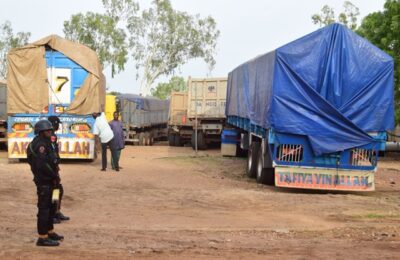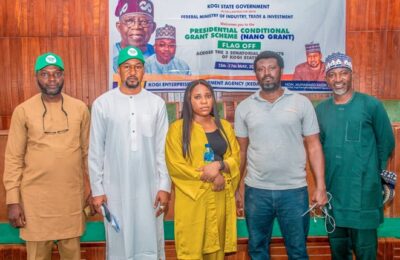The menace of child sexual abuse has become a major threat to the safety and wellbeing of children. This has added to the numerous challenges of parenting in the current age of Information and Communication Technology.
The sad tales of abuse of these innocent and most vulnerable set of people have more or less become a daily occurrence on radio, television, newspapers, social media and other forms of communication.
It is important to state that most of the cases that occur in rural areas are either hardly reported or under reported.
According to a Survey by United Nations International Children Emergency Fund (UNICEF) on 10 September 2015, it was revealed that 1 in 4 girls and 1 in 10 boys had experienced sexual violence in Nigeria before the age of 18 years.
From the above statistic, it is obvious that the girl child is more at risk of sexual abuse than the male child. Child sexual abuse therefore is a form of violence perpetrated by sexual predators against innocent children in contravention of international and national legal instruments.
Who Is A Child?
According to the UN Convention on the Rights of the Child which has been domesticated in Nigeria as the Child Rights Act, 2003, a child is defined in Section 277 of the Act to mean a person under the age of eighteen years”. Therefore, anyone who is below 18 years under the Nigerian law is a Child.
To avoid any ambiguity, the Act in further state that the “”age of majority” means the age at which a person attains the age of eighteen years.
It is worthy to state that the above definition is the globally accepted one which does not admit of any peculiarity on the basis of culture, religion or other considerations.
What Is Child Sexual Abuse?
According to Wikipedia, Child sexual abuse is a form of molestation in which an adult or older adolescent uses a child for sexual stimulation. It includes engaging in sexual activities with a child (whether by asking or pressuring, deceiving, coercing, use of force and violence or by other means), indecent exposure (of the genitals, female nipples), child grooming, and child sexual exploitation. It also entails the use of a child to produce pornography.
Sexual abuse involves forcing or enticing a child to take part in sexual activities, whether or not the child is aware of what is happening.
Signs of sexual abuse:
According to e Association of International Schools in Africa (AISA), Child Protection Handbook, 2016 2 Edited by Chanel Ryall, the following signs of sexual abuse where stated:
a Pain or irritation to the genital area
b. Vaginal or penile discharge
c. Difficulty with urination
d. Infection, bleeding
e. Contraction of Sexually Transmitted Diseases (STDs)
f. Fear of people or places
g. Mentioning receiving special attention from an adult or a new “secret” friendship with an adult or young person
h. Regressive behaviours (a child beginning to engage in behaviours he or she had stopped or out grown a long time ago) such as bed wetting or stranger anxiety
i. Age inappropriate sexualized behaviour or language
j. Being unusually quiet and withdrawn or unusually aggressive
k. Suffering from what seem physical ailments that can’t be explained medically
l. Showing fear or distrust of a particular adult
m. Aggression
n. Refusal to continue with school or usual social activities
p. Excessive masturbation/Sexually provocative
Child sexual abuse can be contact and non contact form:
a. The Contact form. This is the most prevalent form of sexual abuse as a form of sexual abuse which in most cases leave physical evidence, scars, and marks and can easily be prosecuted. This includes engaging in actual sexual activities, penetration, kissing, fondling, sucking or playing with genitals, fingering etc. In other words, any form of child sexual abuse that involves physical contact is regarded as contact form of child sexual abuse.
b. Non – Contact form. This is tricky in the sense that it involves no form of physical despite the abuse. In cases of children who are unable to talk or express themselves, this may be difficult to discover as there may be no physical mark. Examples of non-contact form of child sexual abuse includes having sex in the presence of a child, voyeurism, exposing a child to pornography and adult rated scenes, music or materials, walking naked especially in the presence of children etc.
It is to be noted that several parents, perhaps out of ignorance are guilty of some of the examples of non-contact form of child sexual abuse enumerated above. Even though this form of abuse is considered innocuous, hence, hardly talked about, its effect on the mind and psychology of a child could be devastating for a child.
There is no doubt the fact that children are great imitators and love to copy all what they watch and see; whether good or bad, especially when it is done by parents, guardians, caregivers among others.
Therefore, if a child is exposed to pornography, physical sex or adult rated content they are likely to imitate the act with their peers. Also, adults may take advantage of this knowledge to sexually molest the child.
Have you ever pondered on how your child learnt some things you feel he/she was too young to understand? This may be a clue to what he/she may have been innocently or inadvertently exposed to either by the parent or other caregiver.
Often, you hear parents say things like, he/she is a small child, he/she doesn’t understand what is happening, even if the child may not understand what is happening, the image may have been captured in his/her innocent mind which may result in imitation.
Which Child Is At Risk of Child Sexual Abuse?
A typical Nigerian parent may be quick to say God forbid, it is not my child’s portion and other forms of denials. Granted, nobody wishes himself/herself or their loved ones evil, the fact remains that child sexual abuse doesnt just happen, they are rampant. The fact that you are unaware does not necessarily mean that your child is one hundred percent safe.
As parents, it is better to stay at alert and arm yourself with relevant information on Child Sexual Abuse than to live in denial or exhibit indifference till you are caught off guard.
Regrettably, available statistics revealed that every child is at the risk of child sexual abuse. Similarly, it was found that in 90% cases of child sexual abuse, the perpetrator is someone known to the survivor/victim or their parents/guardians. Find below some relevant information on the subject:
1. According to Cece Yara Foundation, while 1 in 4 girls is being abused by a neighbour, 1 in 10 girls is being abused by a family member. Also, while 1 in 3 boys is being abused by a neighbour, 1 in 31 boys is being abused by a family member.
2. According to Vera Center on Victimization and Safety, children with disabilities are three times more likely to be victims of sexual abuse.
3. Available data also indicate that children from broken home, violent or abusive homes and single parents household are twice more likely to be sexually abused as they are seen as easy prey by predators because of their need for care love and attention than children from a stable/happy family.
The Challenge of Child Sexual Abuse in Nigeria in the Face of the Child Rights Act 2003
In 2003, the National Assembly enacted the Child Rights Act which as earlier noted, was a domestication of the UN Convention on the Rights of the Child. The Act, among others, expanded the scope of human rights under the 1999 Constitution to cater for rights of children.
Given that Nigeria practices a federal system of government, there was the need for the various State Houses of Assembly to replicate the Child Rights Law in their respective States. This implies that the current Act is only operational at the Federal level and some other states that have domesticated same.
Unfortunately about 11 northern states in Nigeria have are yet to domesticate the Child Rights Act. The states are Adamawa, Bauchi, Borno, Gombe, Jigawa, Kebbi, Kano, Katsina, Sokoto, Yobe, Zamfara.
It was argued that some of the provisions of the Act, on the definition of a child and express prohibition of child marriage/child sexual abuse in Sections 31 and 32 of the Child Rights Act are considered to be against Islamic belief, hence the outright refusal to domesticate the Act. The law expressly states that any sexual intercourse with a child is child sexual abuse as a child lacks capacity to grant a valid sexual consent
A highlight of some of the provisions under the Child Rights Act are:
Section 31 – Unlawful sexual intercourse with a child, etc.
(1) No person shall have sexual intercourse with a child.
(2) A person who contravenes the provision of Subsection (1) of this section commits an offence of rape and is liable on conviction to imprisonment for life.
(3) Where a person is charged with an offence under this section, it is immaterial that‐ (a) the offender believed the person to be of or above the age of eighteen years; or
(b) the sexual intercourse was with the consent of the child.
Other Forms of Sexual Abuse and Exploitation
Section 32 stipulates other forms of Sexual abuse and exploitation:
(1) A person who sexually abuses or sexually exploits a child in any manner not already mentioned under this Part of this Act commits an offence.
(2) A person who commits an offence under subsection (1) of this section is liable on conviction to imprisonment for a term of fourteen years.
It is important to state that apart from the 11 states which are yet to domesticate the Child Rights Act, the general implementation and effectiveness of the Act in the country left so much to be desired. Another limitation of the Act is the fact that it has no provisions for non-contact form of child sexual abuse. The existing law focuses more on actual penetration. Notwithstanding, with nationwide and strict implement, the Child Rights Act, 2003 is a right step in the right direction towards the protection and safety of children, our future generation.
– Barr Elizabeth E. Achimugu, an Abuja based Child Rights Advocate is the Executive Director, Protect the Child Foundation and can be reached via achimuguelizabeth@gmail.com





